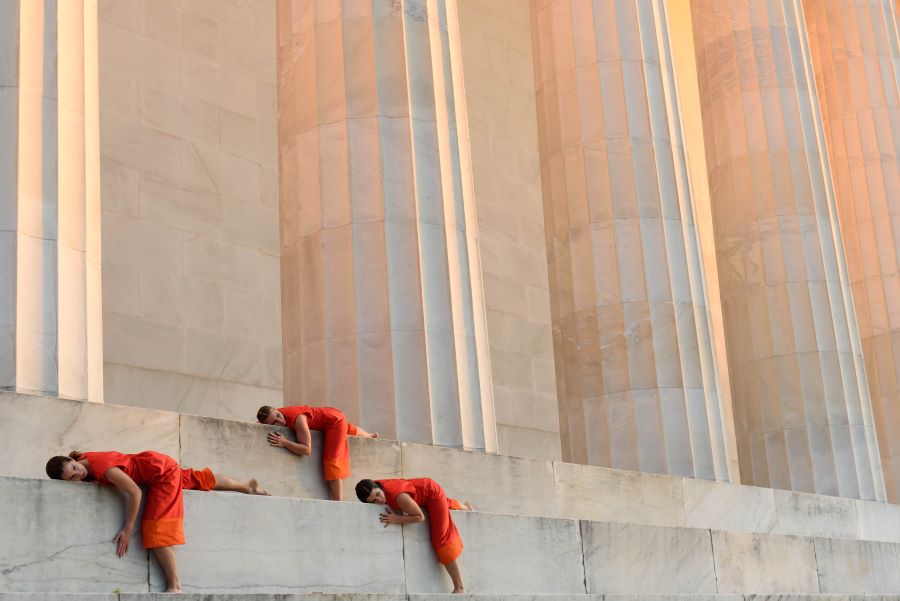Georgia engages with issues of public social space, collective ritual behaviour and notions of sacred space in both ancient and contemporary cultures.
Image: Georgia SAXELBY, Lullaby (still from video performance), 2017, in collaboration with Viva Soudan and Bailey Nolan. Photo: Kristin Adair.
GEORGIA SAXELBY (NSW)
Georgia Saxelby is an interdisciplinary artist living and working between Sydney and the United States. Her participatory practice engages with issues of public social space, collective ritual behaviour and notions of sacred space in both ancient and contemporary cultures. Saxelby is a Fellow at the art and social impact incubator, Halcyon Arts Lab, Washington, DC creating participatory installations that investigate contemporary cultural relationships to women and feminine identity through invented ritual practices and symbolic actions. Saxelby recently presented a solo exhibition, To Future Women, at The Phillips Collection, which travelled between cultural institutions in Washington, DC, including the Hirshhorn Museum & Sculpture Garden. Her scholarship takes her to Carnegie Mellon University, Pennsylvania, US to complete a Masters of Fine Arts.
Artist's website: georgiasaxelby.com
An urgent curiosity propels Georgia Saxelby to make art of our time. Her recent practice is one of inviting questions and provoking responses – a strategy very familiar in contemporary art – but it is the environments she conceptualises and the sheer ambition and scope of these works that distinguish them.
Originally trained in painting, as her practice developed Saxelby introduced a subtle element of engagement design to her installation. She was immediately struck by the way that this element transformed the artwork’s viewers into its participants. Intrigued at the implicit power she now held as an artist, Saxelby has gone on to place engagement as central to the act of art-making.
This aspect of her work has grown into a duel interest in interrogating cultural rituals and the way that they bind individuals into a community, as well as the way architectural space shapes such practices. Saxelby senses that her interest in ritual and participatory design stems from growing up in a place where, for her, such embedded connectedness was absent - the Australian suburb. That place of vaunted financial and familial security, the location that captured the imagination of post-war Australia and codified the norms of national aspiration for generations, left Saxelby looking for something more.
For the past two years she has lived between the US and Australia. Her work and residencies in New York and Washington DC have made her both a witness to and participant in an historic period of political and social upheaval.
She has quickly reckoned with the potential that art-making has in this age of participatory social media, a 24-hour news cycle and the accelerated availability of content on digitally accessible archives. For Saxelby these are all new tools of the artist. She is also, however, attuned to the continuing power of the physical presence of art.
Her design for To Future Women, her largest project to date, came out of the experience of participating in the Women’s March in Washington DC on January 21st 2017. This march was a transformative moment for many of her generation who had never witnessed such a large-scale social protest, and Saxelby sought to develop an art project that might extend that conversation into the future. She approached key museums in Washington to host her installation design, where visitors were invited to write a letter to women of the future. A simple yet powerful idea, it went on to capture the imagination of thousands of participants who could not only sit and write their own letter but also view others on display. To Future Women ran for six months in venues such as The Philips Collection, community museums, artist-run spaces, and the Hirshhorn Museum, located right beside the National Mall where the Women’s March took place.
Using predominantly red and white, Saxelby designed a series of seating areas and temporal structures for the letters’ displays, each one responding to the specifics of its architectural space. She observed how museums have become social temples for new kinds of ritual behavior, and how important they are as spaces of safe and open dialogue. Saxelby has also begun working with national museums to index and store To Future Women’s letters, creating an historically important archive that will be released and exhibited in 2037 to mark the 20th anniversary of the Women’s March.
With Lullaby, a work filmed at the imposing Lincoln Memorial, and The Architecture of a Witch’s Hut, Saxelby has undertaken further ambitious performance installation works that seek to challenge the architectural legacy of loaded historical structures and their ritualised constructs that diminish women.
With the Samstag Scholarship, Saxelby plans to return to the United States and continue to study, research and make work of these extraordinary times.
Virginia Rigney is a curator and arts writer in Canberra, Australian Capital Territory.

